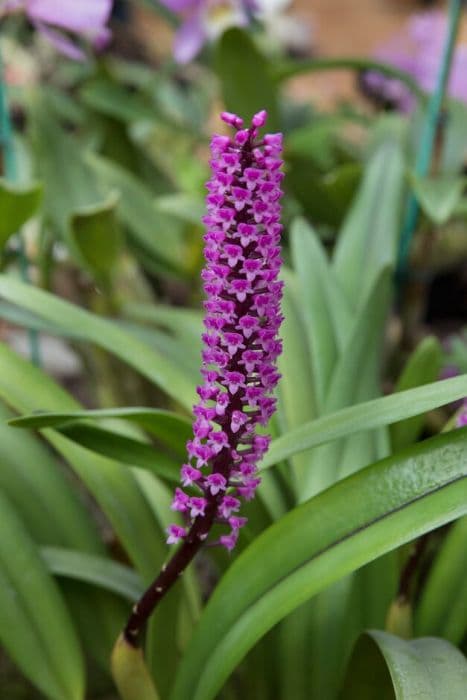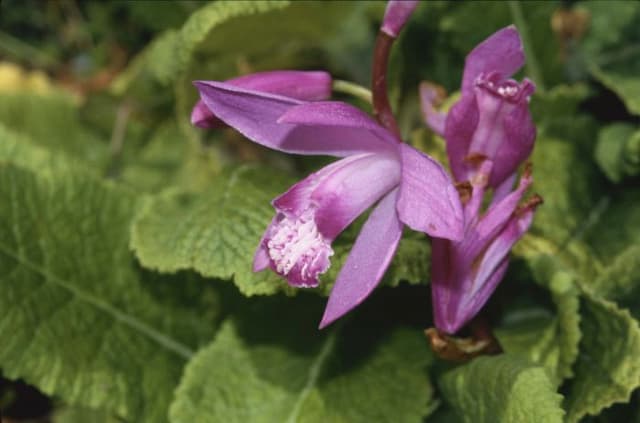Moth Orchid Phalaenopsis Brother Pico Sweetheart gx

ABOUT
The Phalaenopsis Brother Pico Sweetheart gx, commonly known as Moth Orchid, is well known for its visually striking and long-lasting flowers. Its blooms can vary in color but often display a gradient of white that transitions into a rich pink or purplish shade at the edges. These flowers are characterized by their rounded petals and a slightly larger lip, which may have a contrasting pattern or spots. The blossoms are arranged on a sturdy, arching stem that gracefully emerges from a rosette of broad, glossy green leaves. The leaves of the Moth Orchid are thick and leathery, forming a substantial base from which the flower spike arises. The overall appearance of this plant is elegant and can provide a touch of exotic beauty to any setting in which it is placed.
About this plant
 Names
NamesFamily
Orchidaceae
Synonyms
Moth Orchid, Phal.
Common names
Phalaenopsis Brother Pico Sweetheart gx
 Toxicity
ToxicityTo humans
The Phalaenopsis Brother Pico Sweetheart, commonly known as the Moth Orchid, is not considered toxic to humans. Therefore, ingesting any part of this plant typically does not result in poisoning or adverse symptoms.
To pets
The Moth Orchid is also non-toxic to pets such as cats and dogs. Ingesting parts of this plant is not expected to cause any poisoning or severe symptoms in pets. However, any non-food item can potentially cause mild stomach upset if consumed in large quantities or if the pet has a particularly sensitive digestive system.
 Characteristics
CharacteristicsLife cycle
Perennials
Foliage type
Evergreen
Color of leaves
Green
Flower color
Varies
Height
1 foot [30 cm]
Spread
1 foot [30 cm]
Plant type
Herb
Hardiness zones
11
Native area
Asia
Benefits
 General Benefits
General Benefits- Easy to Care For – Phalaenopsis orchids are among the easiest orchids to maintain, making them ideal for beginners.
- Long-Lasting Blooms – These orchids can have flowers that last for months, providing extended enjoyment.
- Aesthetic Appeal – With their elegant appearance, they can enhance the beauty of any indoor space.
- Availability – They are widely available and come in a variety of colors and sizes to suit different preferences.
- Hybrid Vigor – Being a hybrid, the Phalaenopsis Sweetheart is generally robust and adaptable.
- Compact Size – Suitable for small spaces like apartments and offices without taking up too much room.
- Non-Toxic to Pets – They are safe to have in a home with pets, as they are not known to be toxic.
- Mood Enhancer – The presence of flowers indoors can improve moods and create a calming environment.
- Ideal for Gifting – Their attractive blooms and ease of care make them a popular gift choice for a variety of occasions.
- Year-Round Bloom Potential – With proper care, they have the potential to flower multiple times a year.
 Medical Properties
Medical PropertiesThis plant is not used for medical purposes.
 Air-purifying Qualities
Air-purifying QualitiesThis plant is not specifically known for air purifying qualities.
 Other Uses
Other Uses- Photography Subject: The striking flowers of Phalaenopsis orchids can serve as a captivating subject for macro and portrait photographers, offering a chance to capture detailed images and explore color composition.
- Edible Garnishes: Although not widely known for edibility, the flowers can occasionally be used as decorative, non-toxic garnishes for desserts and cocktails after ensuring they're free of pesticides.
- Educational Material: Horticulture courses and workshops can use these orchids as examples to teach about epiphytic plant care, hybridization, and the lifecycle of orchids.
- Artistic Inspiration: The unique form and beauty of the Phalaenopsis orchid often inspire artists and craftspeople to create paintings, sculptures, and jewelry designs.
- Wedding Decor: Beyond traditional floral arrangements, the long-lasting blooms are ideal for creating wedding accessories like boutonnieres, corsages, or hair adornments.
- Fashion Prints: Phalaenopsis's dynamic shapes and colors can inspire textiles and fashion designs, translating its patterns onto fabrics for clothing or accessories.
- Color Dye Source: Experimentally, the pigments from the petals may be used to create natural dyes for fabrics or art projects.
- Aromatherapy Decoration: While not inherently fragrant, these orchids can be displayed in aromatherapy settings, adding visual calmness to spaces dedicated to relaxation and meditation.
- Still Life Studies: In fine arts, these orchids often make excellent subjects for still life compositions, helping artists practice color blending and shading techniques.
- Terrariums and Fairy Gardens: Miniature varieties can be incorporated into terrariums or fairy gardens, adding a magical or tropical element to these small-scale ecosystems.
Interesting Facts
 Feng Shui
Feng ShuiThe Phalaenopsis orchid is believed to bring good luck, love, and positive energy when placed in the home or office. According to Feng Shui principles, it should be positioned in areas related to personal growth, relationships, or scholarly pursuits. It’s particularly beneficial in the bedroom for promoting romantic energy or in the study to foster creativity and wisdom.
 Zodiac Sign Compitability
Zodiac Sign CompitabilityThe Phalaenopsis orchid is not used in astrology practice.
 Plant Symbolism
Plant Symbolism- Beauty: The Phalaenopsis orchid, commonly known as the Moth Orchid, is often associated with beauty due to its elegant and exotic blooms that can come in various colors and patterns.
- Refinement: With its delicate and sophisticated appearance, the Moth Orchid symbolizes refinement and luxury.
- Love: As a gift, these orchids are commonly presented to convey love, with the long-lasting flowers representing a relationship's enduring nature.
- Fertility: Because orchids can produce numerous seeds, they have come to symbolize fertility and abundance.
- Strength: Despite their delicate looks, orchids are resilient and can adapt to different environments, thus symbolizing strength and the ability to endure challenging conditions.
 Water
WaterWater your Phalaenopsis orchid thoroughly once a week, allowing water to flow through the potting medium and out the bottom of the pot to ensure complete saturation. Moisten the medium with approximately one quart of water, depending on the size of the pot, until the excess drains away. Do not let the plant sit in water, as this can lead to root rot. It's important to water in the morning, giving the plant time to dry before cooler nighttime temperatures. Ensure that the leaves remain dry to prevent bacterial growth. Depending on humidity and temperature, you may need to adjust watering frequency, but always check that the top inch of the potting medium is dry before re-watering.
 Light
LightThe best light conditions for a Phalaenopsis orchid is bright, indirect sunlight. Placing the plant near an east or west-facing window where it can receive gentle morning or afternoon light is ideal. Direct sunlight should be avoided as it can burn the delicate leaves of the orchid. If the light is too low, the plant may not bloom, so ensure it gets sufficient light without exposing it to direct sun.
 Temperature
TemperaturePhalaenopsis orchids prefer temperatures between 65 and 80 degrees Fahrenheit during the day and no lower than 60 degrees Fahrenheit at night. They can withstand a maximum temperature of approximately 95 degrees Fahrenheit, but should not be exposed to temperatures below 50 degrees Fahrenheit as this can damage the plant. Maintaining these temperature ranges will help ensure healthy growth and flowering.
 Pruning
PruningPrune your Phalaenopsis orchid to remove dead or yellowing leaves, spent flower spikes, and to maintain its shape. Pruning is typically done after the plant has finished blooming, which is the best time to cut back the flower stalk down to the node where a previous flower bloomed. This may encourage a second round of flowering. Pruning should be done with sterilized scissors or shears to prevent the spread of disease, and only when necessary.
 Cleaning
CleaningAs needed
 Soil
SoilThe best soil mix for a Phalaenopsis orchid, commonly known as the Moth Orchid, consists of a well-draining, chunky medium like bark chips, sphagnum moss, and perlite. These orchids thrive in soil with a pH of around 5.5 to 6.5, slightly acidic, which mimics their natural tree-bound habitat.
 Repotting
RepottingMoth Orchids should typically be repotted every 1 to 2 years or when the potting medium starts to decompose. The best time to repot is just after the plant has finished flowering and new growth appears.
 Humidity & Misting
Humidity & MistingHumidity levels for Moth Orchids should be between 40% and 70%. They thrive in a moderately humid environment, which helps simulate their native tropical conditions.
 Suitable locations
Suitable locationsIndoor
Place in bright, indirect light and high humidity for indoor growth.
Outdoor
Grow outside in dappled shade with protection from extreme weather.
Hardiness zone
Moth Orchids are suitable for 10-12 USDA.
 Life cycle
Life cycleThe Phalaenopsis orchid, commonly known as the moth orchid, begins its life cycle when a seed germinates, typically requiring a symbiotic relationship with a fungus to provide it with essential nutrients. As the seedling matures, it develops leaves and a root system that enable it to photosynthesize and obtain water and minerals from its typically epiphytic environment. Over time, the orchid grows into a mature plant with a larger root system and multiple broad, green leaves that arise from a central stem or rhizome. Upon reaching maturity, which can take several years, the orchid produces a flower spike, which will develop buds that blossom into the characteristic showy flowers. After pollination, which can be performed by insects in the wild or artificially in cultivation, the flowers can produce seed capsules containing thousands of minute seeds. Once the flowers have been pollinated and faded, the plant may enter a period of dormancy before beginning the cycle again with the development of new leaves and flower spikes in subsequent seasons.
 Propogation
PropogationPropogation time
Spring to Summer
The Phalaenopsis orchid, commonly known as the Moth Orchid, is typically propagated through the division of its offsets, also known as keikis, which the plant naturally produces. The best time for propagation is usually after the orchid has finished flowering, when the plant is not directing its energy into bloom production. The most popular method for propagating Phalaenopsis orchids is through the separation of these keikis. Once a keiki has developed several roots at least an inch (or about 2.5 centimeters) long, it can be carefully removed from the parent plant using a sterilized cutting tool. The young plant is then potted in its own container with appropriate orchid potting medium, where it will grow into a new, independent orchid with care and time.








